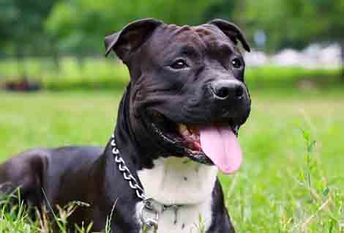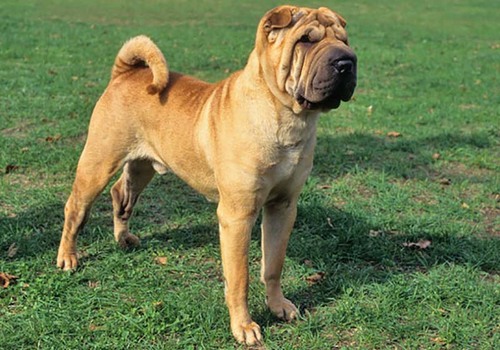Grooming requirements depend on individual Shar-Pei. Weekly brushing can meet the needs of both the “horse-coated” (shorthaired) variety and the “brush-coated” type (slightly longer), but some Shar-Pei of either type can be prone to skin problems. Shar-Pei with skin problems may need weekly bathing and daily brushing.
All Shar-Pei need regular wrinkle care. The wrinkles must be wiped out with a damp cloth and then dried thoroughly to prevent infection. Do not oil the skin.
Shar-Pei has small, tight, triangular ears that predispose them to chronic ear problems because there isn’t enough air circulating in the narrow ear canal. Although it’s not as easy to clean the ears of a Shar-Pei as it is for most breeds, regular cleaning should be done to help prevent recurrent yeast or bacterial infections.
Check the ears on a weekly basis for signs of infection, irritation, or wax build up. Cleanse regularly with a veterinarian-approved cleanser and cotton ball. Brush the teeth at least once per week to prevent tartar buildup and fight gum disease. Additionally, nails should be trimmed once per month if the dog does not wear down the toenails naturally.
The Shar-Pei is a medium breed of dog that is moderately energetic. He does not need a lot of exercises, but it should be brisk or just long enough to burn off energy. A quick30-minute walk every day is a good idea or lively games during the day. Short, but energetic games 2 or 3 times during the day are ideal, especially when the weather is warm.
With this said, Shar-Peipuppies should not be given too much exercise because their joints and bones are still growing and too much pressure on them could result in causing a dog a few problems later on in their lives. They should not be allowed to jump up or off furniture nor should they be allowed to run up and down the stairs because this puts too much pressure on their still growing joints and limbs.
Walk – brisk moderate walk 20 to 40 minutes
Lively games (indoors or out) likeFetch
Games that involve mental challengeslikeHide and Seek
Training sessions,especially good as the Shar-Pei can be headstrong without training
A Chinese Shar-Pei should have a healthy and even voracious appetite at times has a relatively large frame. Good meats and poultry are considered healthy and natural foods for a dog of this type, and it’s important to remember to incorporate other whole ingredients into a dog’s diet so as to maintain a healthy coat and body.
If you get a Samoyed puppy from a breeder, they would give you a feeding schedule and it's important to stick to the same routine, feeding the same puppy food to avoid any tummy upsets. You can change a puppy's diet, but this needs to be done very gradually always making sure they don't develop any digestive upsets and if they do, it's best to put them back on their original diet and to discuss things with the vet before attempting to change it again.
Older dogs are not known to be fussy or finicky eaters, but this does not mean you can feed them a lower quality diet. It's best to feed a mature dog twice a day, once in the morning and then again in the evening, making sure it's good quality food that meets all their nutritional requirements. It's also important that dogs be given the right amount of exercise so they burn off any excess calories or they might gain too much weight which can lead to all sorts of health issues. Obesity can shorten a dog's life by several years so it's important to keep an eye on their waistline from the word go.
Learn about which human foods are safe for dogs, and which are not. Check with your vet if you have any concerns about your dog’s weight or diet. Clean, fresh water should be available at all times. Like many large breeds, Saint Bernard can experience bloat, a life-threatening condition where the stomach distends and twists. The causes of bloat aren’t fully understood, but experts agree that multiple, small meals per day and preventing vigorous exercise around mealtimes may help reduce the chances of it happening.
All dogs have the potential to develop genetic health problems, just as all people have the potential to inherit a particular disease. Run, don’t walk, from any breeder who does not offer a health guarantee on puppies, who tells you that the breed is 100 percent healthy and has no known problems, or who tells you that her puppies are isolated from the main part of the household for health reasons. A reputable breeder will be honest and open about health problems in the breed and the incidence with which they occur in her lines.
There are some unusual and specific health concerns in the Chinese Shar-Pei breed. One of the major problem areas is the eyes; eye disorders including entropion, glaucoma, retinal dysplasia, and SARDS are known to occur in the breed.
The proper training and socialization of a Chinese Shar-Pei from a young age is very crucial in its development. Because it can have a higher propensity to territorial aggression and can be a little worried around strangers, itshould get used to the idea of other humans and should be able to realize that being around them is safe. Training will also require a good degree of patience. If you’re a first-time dog trainer, the Shar-Pei is not the ideal dog to “cut your teeth” on.
Puppies should be properly socialized to develop the amiable, outgoing personality that is characteristic of the breed. They’re successful in performance and companion events such as earthdog, barn hunt, obedience, and agility.












